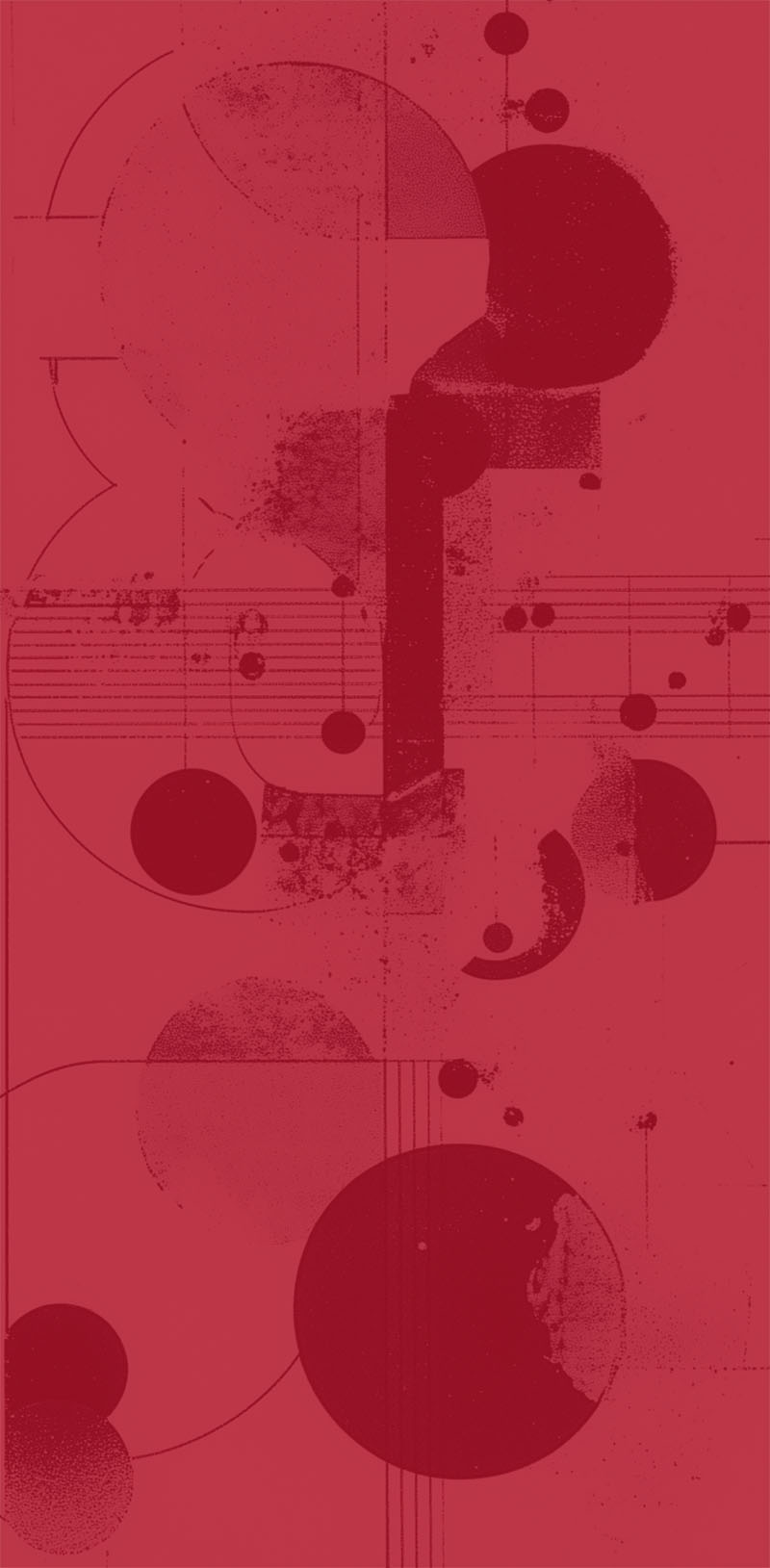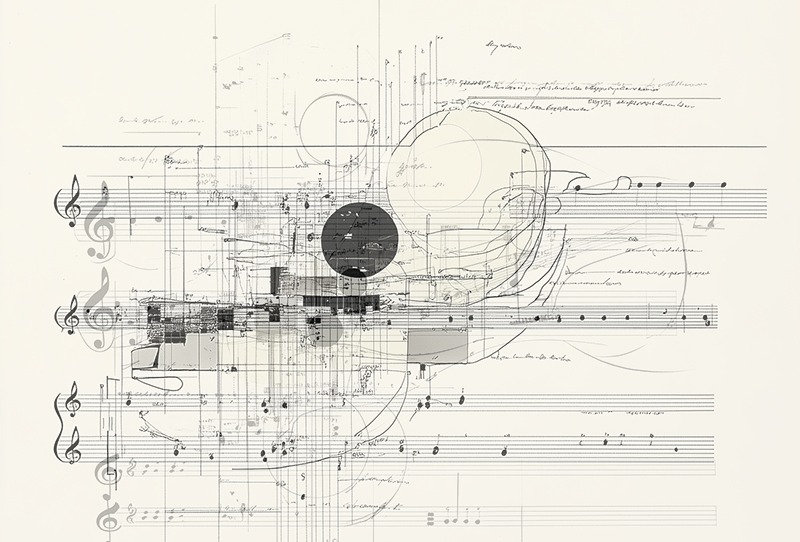
In July 2019 Modulisme was born, Bana Haffar and I contributing the very first 2 Sessions. It was very important that my first guest be a woman, and I’d so much like more Ladies to respond to my invitations, for Modulisme to offer more of a female presence… And fully document our Electronic Music community…
Over the years, I’ve heard it said that the platform offers so much information that the newcomer doesn’t know how to take it in, where to start, that there’s too much to read… A simple reply would be « take your time » because Modulisme wants to share information, give composers a voice and make sure they have the opportunity to be well presented. The fuller their message, the better off I am, so here it’s all about transmission, and of course it may take time to digest… For the better !!!
We are celebrating 5 years of activism and offering more than 1 000 exclusive works showcasing the importance of analog electronic music !
For this series I wanted to emphasize the alliance of acoustic and electronic with a collection of works showing that Modulisme isn’t dealing with Modular synthesis only and that what matters is the composition rather than the tools.
ACOUSTRONIQUE features music composed of sounds artificially created using the modular instrument, enriched with natural sounds (field recordings/voices) or acoustic material (instruments).
This is volume 5 which I chose to limit to 2 hours so as to keep it digest…
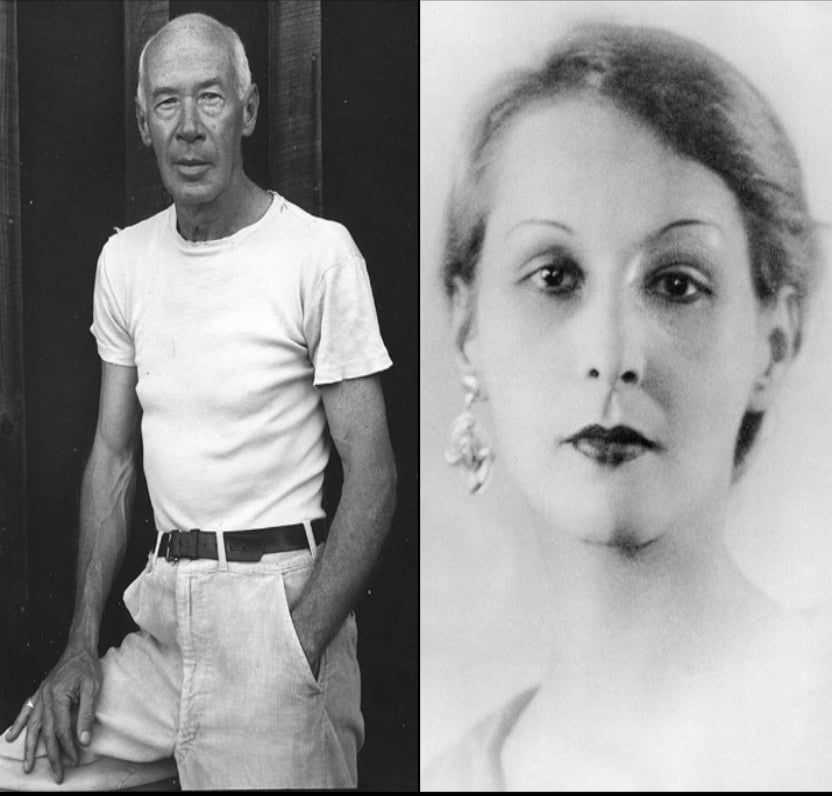
01. Kathryn & Scot Gresham Lancaster – Sexus (06:28)
Kathryn Gresham-Lancaster is a writer, playwright, performer, and teacher currently living in Brunswick, Maine. She co-founded a puppet troupe and wrote and performed children’s puppet shows in schools festivals and private homes. She has spent much of her life in Oakland, CA where she taught programs in puppetry, playwriting, and an ongoing arts program for parents and children. She has written and acted in performance art pieces in the SF Bay area + has published poems, short stories and flash fiction in a number of literary journals and two print anthologies.
Scot Gresham Lancaster is a composer, performer, instrument builder and pioneer in the use of Modular Synthesizer (working for Buchla and Serge back in the early days) and educator working at the boundary between science and art, specifically developing advanced techniques in sonification. He does research and performance using the expanding capabilities of computer networks to create new environments for cross-discipline expression. His interest is in the behavior of interconnected music machines to create innovative ways for performers and computers to interact. Gresham Lancaster has collaborated in »co-located« performances in real time over networks. He has worked with multimedia prototyping and user interface theory.
« Sexus » was first published in 1949. It is the first volume of Henry Miller’s The Rosy Crucifixion trilogy. This autobiographical novel explores his tumultuous relationships, creative struggles, and sexual experiences, delving into themes of desire, freedom, and self-discovery.
This was a collaboration between Kathryn and Scot Gresham-Lancaster in the fall of 1983. Although the voice sounds like a man, this was voiced by Kathryn and pitched down an octave to make it sound more in a man’s voice range. Richard Zvonar, of Diamanda Galas fame, lent the Eventide H949 Harmonizer to do this task. The excerpts were chosen by Kathryn from various parts of the book and recorded by her in the living room of their Oakland home. The voice track was then used in a live performance at the Intersection Gallery on Union St. in San Francisco.
Later the material from that performance was excerpted and remixed at the Mills Center for Contemporary Music with some assistance from Edward Tywaniak. The instruments used were a Buchla 400 system prototype on loan from Don Buchla to CCM, Scot’s six panel Serge Modular, Lexicon Super PrimeTime and PCM70 and the aforementioned Eventide Harmonizer.
This piece is the recorded part of the live performance. Kathryn performed the sections regarding the character “June/Mara” live with the slides, set pieces and shadow puppets which were, unfortunately, not recorded.
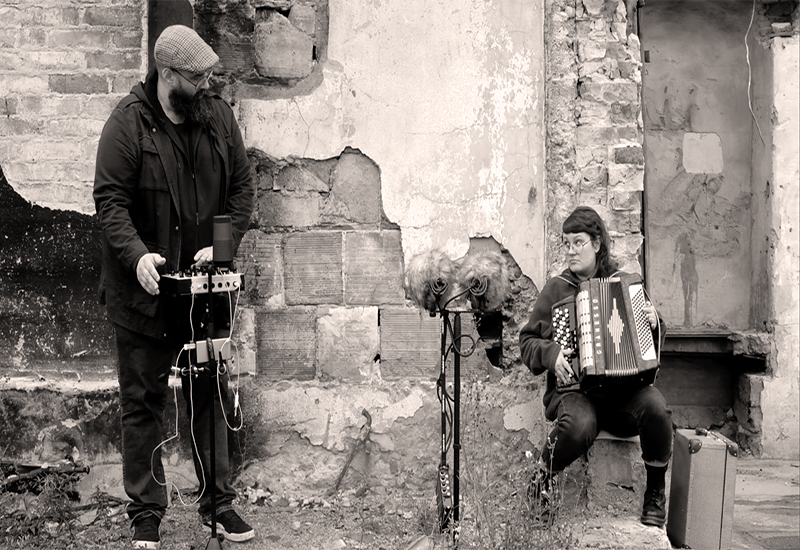
02. Omlopp (Astrid & Marcus Wrangö) – Abrasive Surge (09:04)
Serge 73-75 Modular system: Marcus Wrangö
Bowed Cymbal and Accordion: Astrid Wrangö
Omlopp is a duo that consists of Astrid and Marcus Wrangö, based in Avesta, Sweden. Heavily inspired by the surrounding dark woodlands and the abandoned industrial premises of local mines and industries.
Astrid is a graphical artist and illustrator who has studied art and design at Konstskolan in Stockholm. Currently she explores ink drawing and embroidery focusing on the body as a shape. She plays the accordion, guitar and lately the banjo. Astrid is fascinated by sound characteristics of acoustic instruments and likes to explore the ambiguity of noise.
Marcus is a composer and audiovisual artist working with modular synthesizers, programming and spatial audio. He has studied Electroacoustic music at Royal College of Music in Stockholm. Marcus teaches electroacoustical music at Gotlands School of Composing in Visby and works as tonmeister at Audiorama in Stockholm. He has always had an urge to explore the outer regions of whats possible to hear, do or perform. Marcus loves pure sinewaves, bass and super high frequencies.
He plays Serge modular synthesizers and builds his own softwares.
We usually stumble on certain sounds during late night explorations, and often we work with a combination of improvisation and composed forms. In « Abrasive Surge » the waves of modular sounds is counterpointed by Accordion and cymbal and evolves into a growing surge of calm undulations.
Astrid plays the accordion and we find it fascinating how it blends with electronics, sometimes almost seamless, but at the same time offers the physical randomness of the acoustic instrument. The cymbal on the other hand was a sudden discovery. Marcus showed her how to use the bow on it and it was love at first sound! The noisy screeches mixed with dark sustained hums were extremely satisfying. Also the unpredictability of the sounds made it almost impossible to stop exploring.
Usually Marcus begins with an idea or a vision for the electronics. Astrid then joins with acoustic instruments, improvising and exploring effects and sounds that either fuses or contrasts against the electronic soundscape. We often choose to explore sound worlds in the twilight zone where the aural differences between electronic and acoustic sounds melt together or get diffuse.
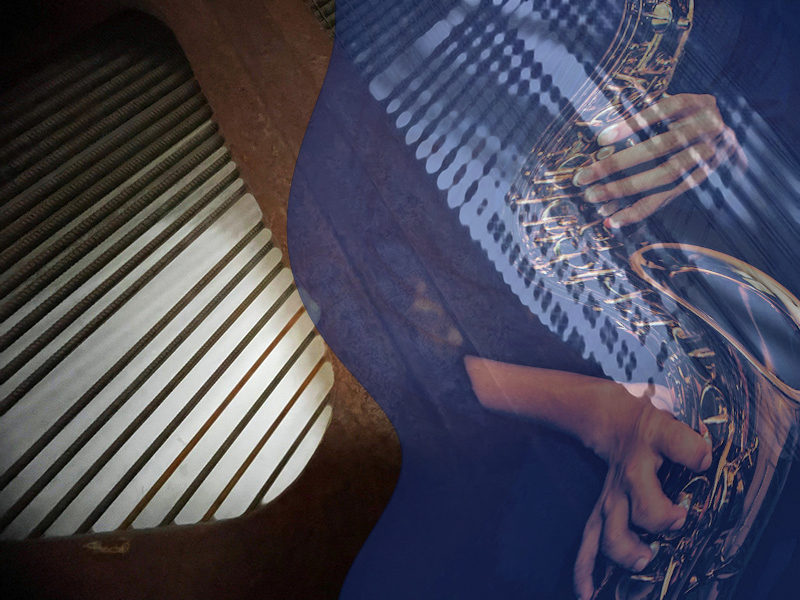
03. Philippe Petit & Martin Archer – aba•dum raba•dum ba•dum (7:58)
P. Petit plays Prepared Piano Soundboard + Buchla 200 Synthesizer
M. Archer plays Saxophones
When I work solo it is very important that I be performing every instrument (whether recording the world around me or playing modular, blowing in some processed Kazoos or plucking strings) anything the listener would hear coming from my playing. Though It may happen that I am after a specific color or sound which I cannot produce myself, and in search of such diversity and exchange I feel lucky to be able to count on some talented friends.
Martin Archer draws inspiration from both free-jazz and contemporary avantgarde music. He plays sopranino, soprano, alto, tenor and baritone saxophones, clarinets, recorders, keyboards, and modular instruments.
A composer and improviser equally at home on stage or in the studio, dividing his energies between jazz and non jazz projects. He operates Discus Music label, and amaong other collaborations is in a long standing duo with vocalist Julie Tippetts, the 2 piece nu-jazz and electronics trio Inclusion Principle, improvising leftfield rock groups Das Rad and Orchestra Of The Upper Atmosphere, and 30 voice performance art choir Juxtavoices… And he’s been releasing records since 1987…
Rather than thinking in terms of scores or other fixed structures, I wanted to take a FREE approach; not necessarily Free-Jazz which over the years has become classic in forms, but simply a leap onto the instrument, if I can put it that way.
I prepared the piano frame and positioned my Buchla 200 synthesizer in front of it so as to be able to pull cables to its envelope followers, and so that at every “touch of string”, the modular could be triggered. Of course, this preparation took a certain amount of time, which allowed me to reflect on my musical desire, its rhythm, intervals, silences and noise zones, but at the same time there remained an uncertainty, an artistic vagueness allowing me to lose myself wherever and whenever I wished… Once I’d found my way back, I could pass it on to Martin who graced my work adding 3 takes playing Alto, Sopranino and Baritone Saxophones…
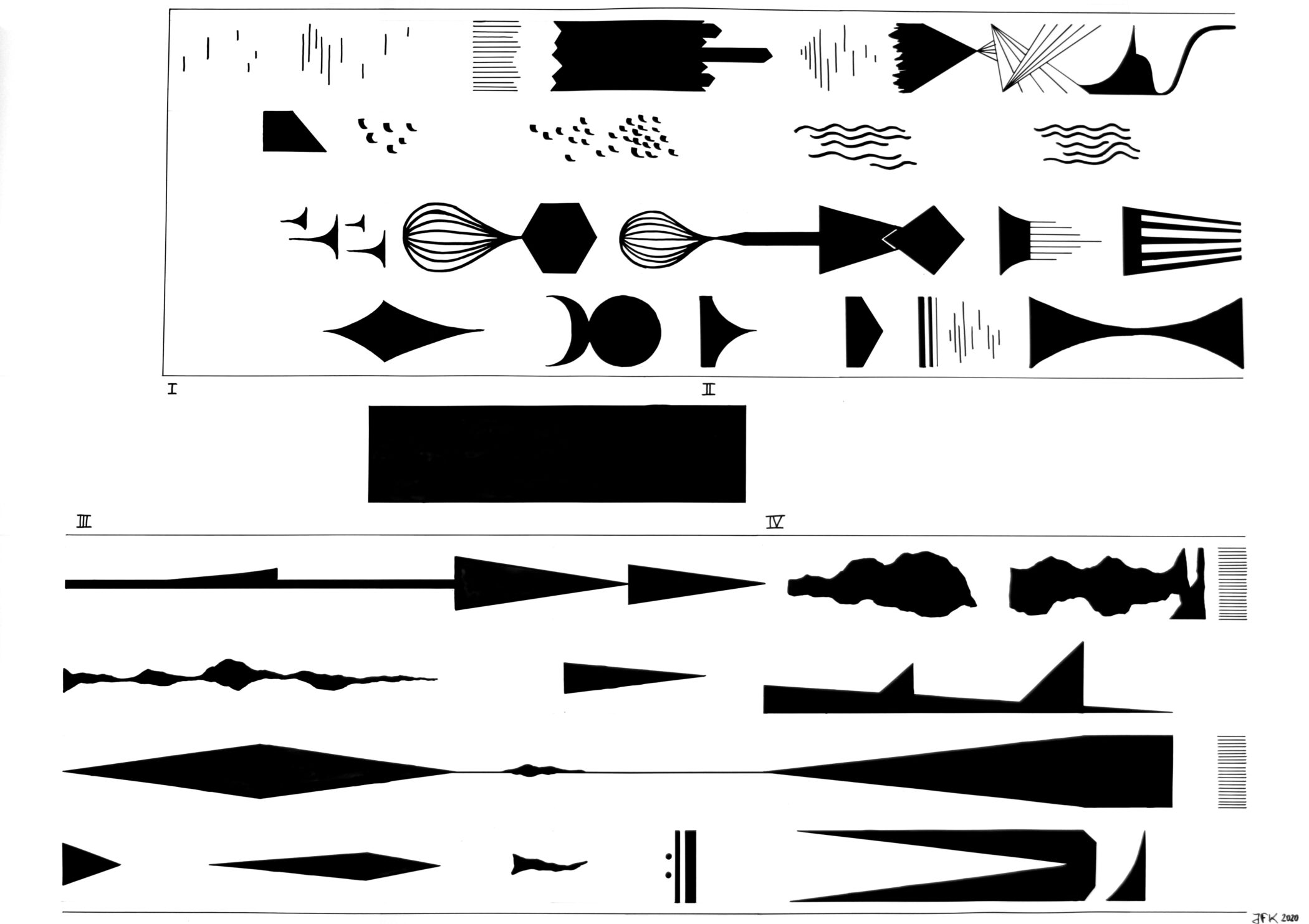
04. Felix Kubin with Ensemble Resonanz – Telephobie (04:51)
2020 (excerpt). For string ensemble and electronics
Electronics: Felix Kubin
Strings: Ensemble Resonanz
Recorded at Resonanzraum, Hamburg
Recording engineer: Karola Parry
Felix Kubin’s artistic universe comprises futuristic pop, Hörspiele (radio plays), electroacoustic music, lecture performances and compositions for orchestra.
Since the end of the 90s he runs his own vinyl label Gagarin Records and has performed at hundreds of international festivals, underground clubs and art institutions including MoMA PS1, Sonar, Transmediale/CTM, Unsound, Moers Festival, Märzmusik, Présences Electroniques, Galerie nationale du Jeu de Paume and Ars Electronica.
In 2019, the French film maker Marie Losier portrayed him in her docu-phantasma “Felix in Wonderland” which ran on ARTE TV. Two of his most established recent collaborations are the sequencer-duo CEL with the Polish drummer Hubert Zemler and a series of multiphonic audiovisual works in public space with the video and performance artist Josephin Böttger.
« Telephobie » was commissioned by the Hamburg-based renowned string orchestra Ensemble Resonanz. I composed the piece during the beginning of the Covid lockdowns, and I believe it is unconsciously tinted by the uneasy silence and threatening uncertainty that came with the pandemic. The original version is about 15 min long and consists of four parts. What we hear in this extract is part III.
The piece is based on a hand-drawn graphic score that is used in a double way:
On the one hand, I play it with a custom-built instrument called “Lichtscanner“, a device that can turn black and white images into digital data by moving it over the drawings. In this piece, the data control a variety of granular samples.
On the other hand, the score is simultaneously interpreted by six string instruments. The playing techniques of the graphic symbols were developed together with the Ensemble Resonanz.
The first reading of the score is nonlinear, the second one linear. In order to achieve a more homogeneous blend of acoustic and electronic timbres, I included both samples of the strings themselves in the granular sampler and asked the players to create some abstract, quasi-electronic sounds.

05. Antonio Russek – Tlajpaloli (15:04)
Antonio Raúl Russek Martínez is a Mexican composer of electroacoustic music and considered a pioneer of sound art in Mexico.
In 1973, he moved to Mexico City and started to compose music for plays + began the construction of ‘musical objects’, motivated by the desire to unite the sound and the visual. In 1974 Russek set up his personal electroacoustic music studio in the Condesa neighbourhood, becoming the first of its kind in Mexico. He founded the Centro Independiente de Investigación Musical y Multimedia (CIIMM) in 1978 and there he carried out musical production, sound settings for exhibitions, recording, as well as publications, editorial and academic work.
Tlajpaloli” means gift in the Nahuatl language and is dedicated to my colleague and dear friend Roberto Morales, celebrating our most recent collaboration with more than 40 years of friendship and shared projects.
All sound materials were obtained directly from the eurorack modular synthesizer I’ve been building recently, sourced with original acoustic samples created from field recordings and sound objects.
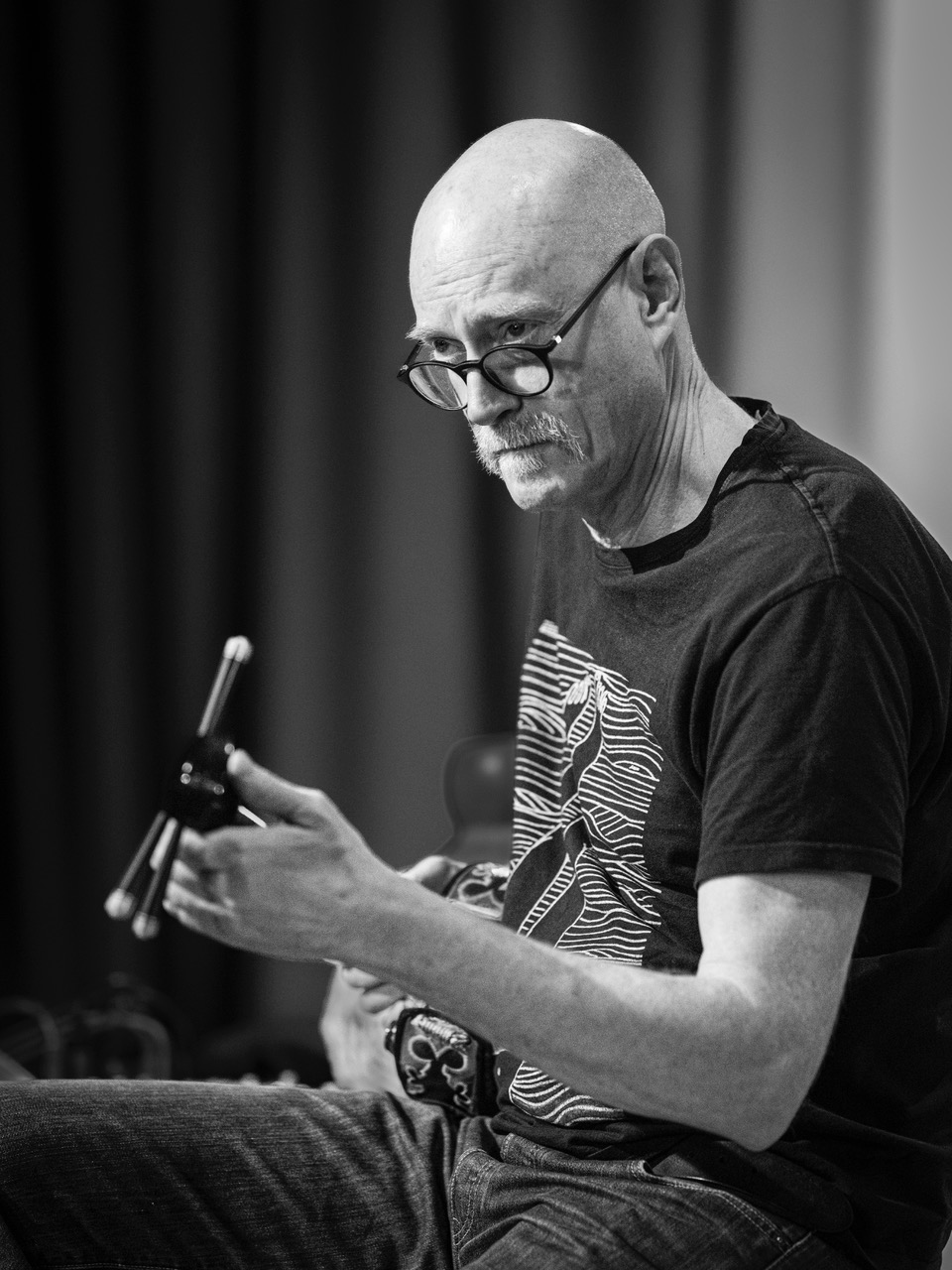
06. Kumo (Jono Podmore) – Fruits de mer (Santé du fer) (09:01)
Jono Podmore aka Kumo is Professor of the Practice of Popular Music at the prestigious Hochschule für Musik in Cologne, Germany.
He has been working under his Kumo alias across multiple releases, live performances and DJ sets worldwide; collaborating with artists as diverse as Can, The Shamen, Jamiroquai, Metamono, Swantje Lichtenstein, Johny Brown and Jhelisa Anderson. The lyrical strains of Podmore’s theremin, more recently the sanshin, and his work with writers, visual artists and in the film industry, all continue to push boundaries.
He’s a regular contributor to music and culture magazines incl. The Quietus, co-wrote and edited the book Jaki Liebezeit (2020) about the master drummer, and co-hosts Talk to the Chip, a podcast and monthly radio show on Resonance FM.
Jono hails from Liverpool and lives with his synths in SE London where he teaches Tai Chi. He is currently writing a major book about drugs and the music industry, and developing a feature film based on Byron’s epic poem The Giaour.
In January I met my friend Toby Izui for lunch in Harajuku, Tokyo. He told me a friend of his, Genshi, had died and left him his collection of instruments, and that he was having trouble finding homes for them all. Who in Tokyo would want a set of bagpipes, for example? Another difficult one was the Okinawan Jamisen. Unknown to Toby I’d wanted one of these instruments for many years, and so a little later I was in his flat taking the Jamisen (or Sanshin) off his hands.
“The sanshin is held in great respect among the Ryukyuan culture, and is often viewed as an instrument that carries the voice of the deities, and is regarded as a deity itself.” It’s a 3 string instrument, the top and bottom strings an octave apart. Its origins are ancient, perhaps Egyptian, and it came to Okinawa from
mainland China, later to end up in Japan to be developed in to the Shamisen. In sharp contrast to my other main instrument the theremin, the dynamic profile of the Sanshin is all about attack and short decay. In « Fruit de Mer, Santé du Fer » I used a variety of techniques to make continua from this almost percussive sound: stretching, looping, tonal reverberations from pianos and gongs, distortion, feedback, etc., creating a series of constantly changing layers, not unlike how the sea appears to people living on islands such as Okinawa. These continua I then fed through Low Pass Gates which I triggered with rhythms from island cultures, not just Okinawa but also the Caribbean and beyond, hence the title.
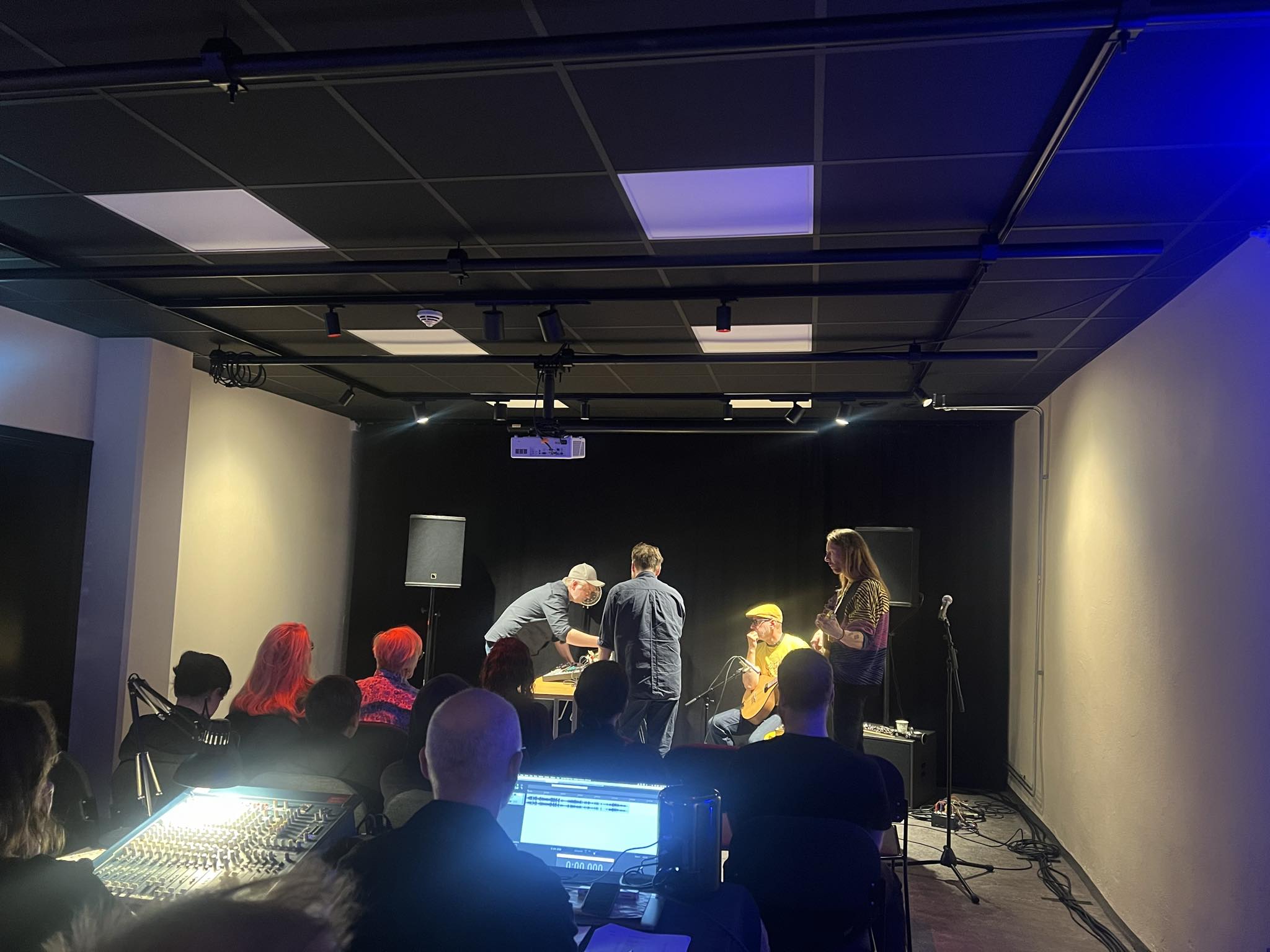
07. Eriksson-Strandhag with Holm & Wiese – EMS Finissage 2 (09:02)
Martin Eriksson is an Architect working in many fields. He is connected to Elektronmusikstudion in Stockholm, EMS.
Håkan Strandhag is a film producer living in Gothenburg and playing with many different bands. Perhaps most notable with Refused for some time in the nineties. Martin and Håkan have been playing in many different configurations for years.
EMS (Elektronmusikstudion) Stockholm celebrates 60-year anniversary this year with an exhibition of their activities during the years at Scenkonstmuseet. The finissage of the exhibition was a number of performances by among others Mari Kretz, Paul Pignon and Eva Sidén.
Martin Eriksson and Håkan Strandhag, together with Martin Wiese and Mikael Holm performed this piece ”Sektion D1” with improvised acoustic instruments, loopers and granular samplers. Martin and Håkan has been working for some time with a method that is thought to allow surprising interaction and demands a focused listening, sensivity and awareness from the performers as well as the audience. Patterns emerge and disappears. The path in a sunny and well kept garden forks and forks and you do not notice until you are far out in the woods and it is getting late.
Due to technical difficulties there were no recording of the actual performance but this is one of the retakes that were made.
Håkan Strandhag plays bass, glockenspiel and clarinet.
Martin Wiese plays the mandola.
Mikael Holm were mixing the different instruments and Martin Eriksson plays the looper and granular sampling.
Since 1964, Elektronmusikstudion EMS is the centre for Swedish electroacoustic music and sound-art. EMS is run as a part of Statens musikverk (National Collections of Music, Theatre and Dance). EMS mission is according to Ordinance SFS 2021:1275 with instructions for Musikverket to: “provide studios to professional composers and sound artists in the field of electroacoustic music and sound art for production, development work and educational activities.”
Besides making professional studios available for the production of electroacoustic music and sound art, EMS’ aim is to support artistic development of electroacoustic music and its integration within other artistic areas. EMS represents electroacoustic music from Sweden in various international contexts and sees as one of its main tasks to act as an informer, both nationally and internationally.
International composers regularly come to EMS to work and may be granted a working period by submitting an Artist in Residence application.
Scenkonstmuseet, the Swedish Museum of Performing Arts is in central Stockholm, housed in one of Northern Europe’s oldest preserved industrial buildings, the beautiful Kronobageriet, dating back to the 17th century. Over the years, it has been used as a bakery, an armoury, and liquor cellar. It’s as much a part of the museum as the objects and installations.
The exhibition is based on the museum’s extensive collection of close to 50.000 objects which have bee naccumulated over more than 100 years. There are both Swedish and foreign objects here, including one of the world’s most important collections of musical instruments.
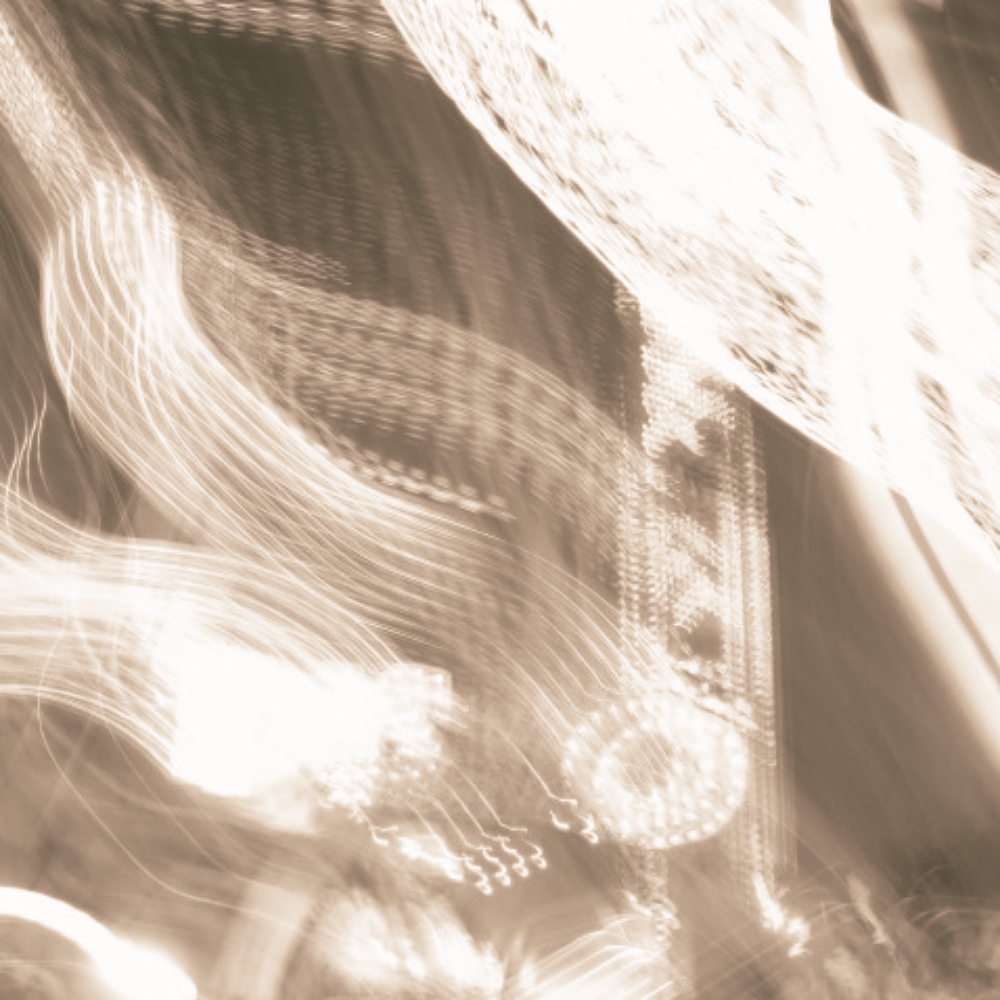
08. Bush Fashion (Mathew Watson & Dave Brown) – C (06:30)
Bush Fashion is an improvisational duo made up of Dave Brown (Pateras/Baxter/Brown, Candlesnuffer, Bucketrider, Brown.Buck.Mayas) & Mat Watson (Solar Cells, ULMD, Taipan Tiger Girls). The seed of Bush Fashion grew from their infrequent collaboration over the past decade in Melbounre’s experimental music scene. Bush Fashion explores non-conformist, collaborative musical language utilising a treated hollow body guitar and matrix programmable portable modular system. Their performances are a wash of nuanced alien language, call and response, and entangled human energy, revealing new realities to the listener.
Our collaborations have usually consisted of treated guitar and Synthi Aks.
These pieces were recorded in one pass a few months ago using a semi-acoustic Gibson ES135 electric guitar in conjunction with a range of the Gamechanger brand guitar pedals and an Erica Syntrx.
We approach our recordings the same way we approach a live performance: no talking, just listen, respond and explore.
Though there is some tonal content and fretting, Dave Brown uses the electric guitar as more of a tone generator and then plays the stomp boxes.
Mat Watson only works with electronic sources but loves the sense he gets from hearing strings resonating and membranes vibrating in the room.
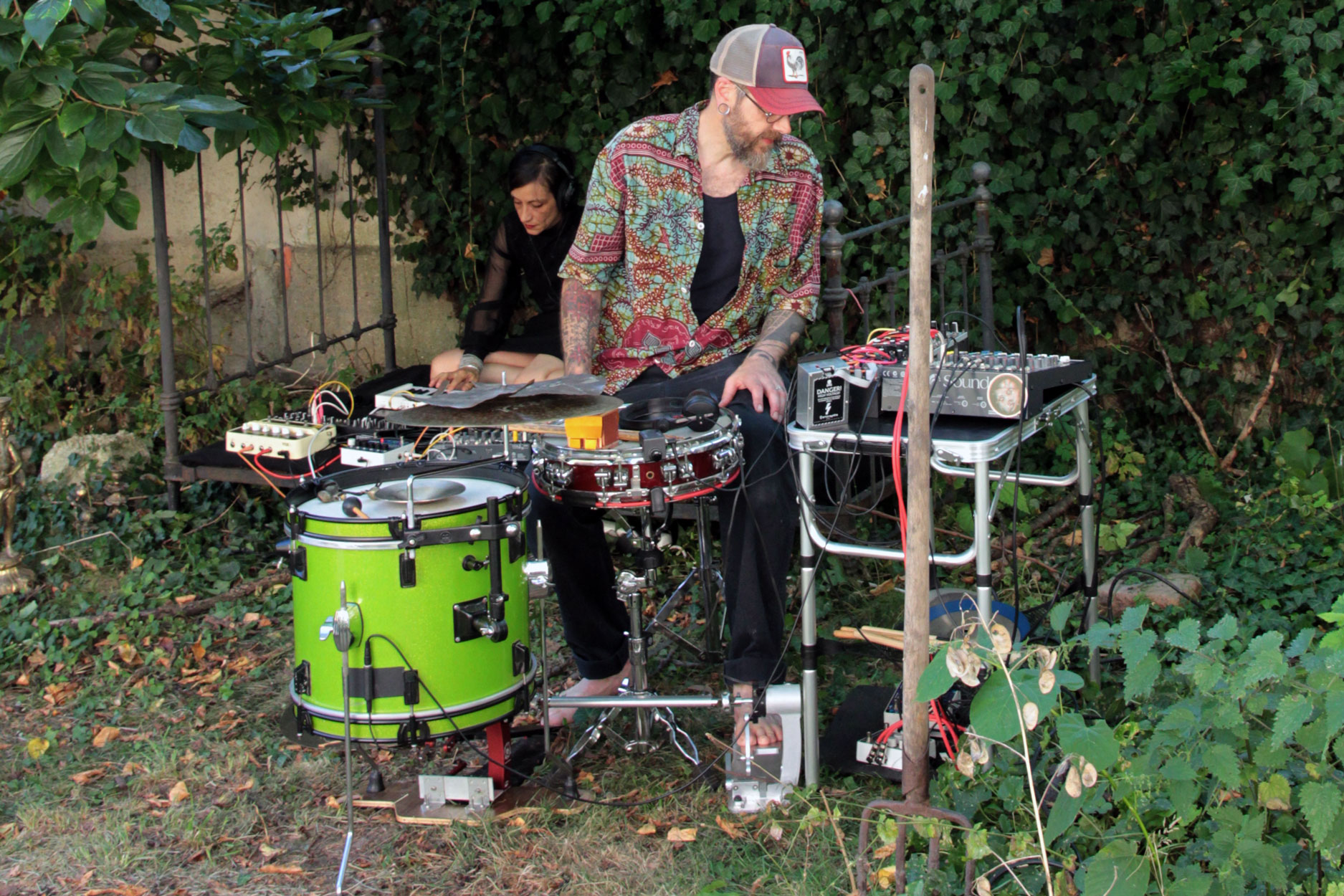
09. Carbon Sink (Magali Sanheira & Gael Angelis) – Endless Summer (10:53)
Carbon Sink s a duo formed by Magali Sanheira and Gael Angelis.
They invite us to enter in an electric world, crossed by AC high voltages, and by electromagnetic waves of luminous gases.
This improvisation piece was first performed at Bruistisme festival, in Le Meine, France.
We wanted to return to our earliest inspirations, the ones that led us to make music in the first place.
Drumming influenced by Ed Blackwell, Rachid Ali and Milford Graves, and a deep, intimate electronic sound with a certain touch of gravity that draws on Tangerine Dream, Nocturnal Emission and Brume. The idea was to create a kind of free jazz that was both dark and psychedelic, with drums and synth instrumentation. An FM tape generator coupled with a modular synthesizer set the scene, over which the drums, triggered by a modular synthesizer, were activated.
Syncopated, erratic rhythms, following the rhythm of a society that takes one step forward and two steps back, of a tragic psychology, the kind that goes beyond melancholy.
And as in all tragedies, it’s the end that gives meaning to the story, that of an endless summer.
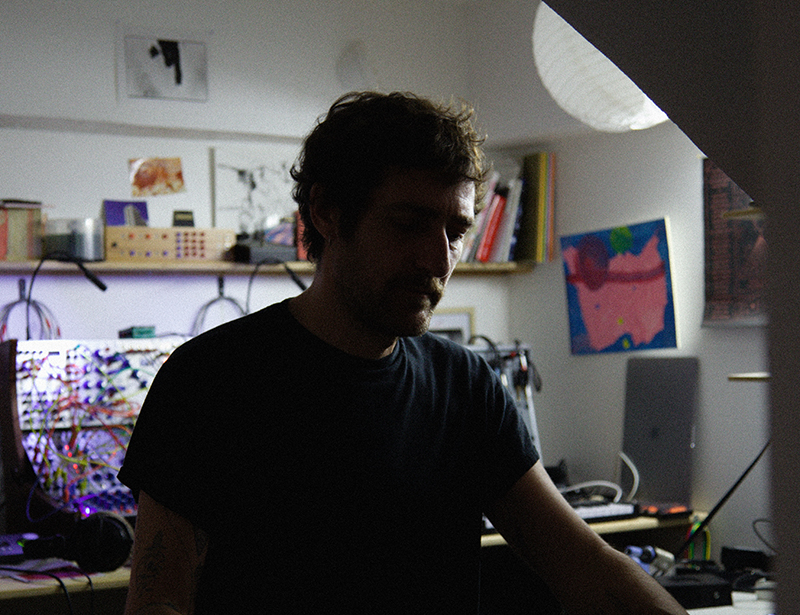
10. Wilfried Thierry – Dodecaphonic Tones And Layered Percussions (05:54)
Sound and visual artist, Wilfried Thierry explores different musical approaches and composes for theater and cinema, creates art performances and installations.
I chose to use acoustic drums with my Buchla system. The drums are the instrument that led me to music by chance when I was a teenager. Even though there were periods in my life when this instrument was more or less present, I always came back to it whenever I could.
For the past two years, I’ve been exploring the possibility of recreating the harmonic and phase-shifting effects of acoustic percussion using the Buchla synthesizer (for instance in Percepts published in « Buchlaisms V »). When Philippe Petit invited me to create a piece mixing acoustics and electronics, it seemed obvious to me to pursue this work on the acoustic properties of percussion, and the two pieces created on this occasion are two different explorations of the same subject.
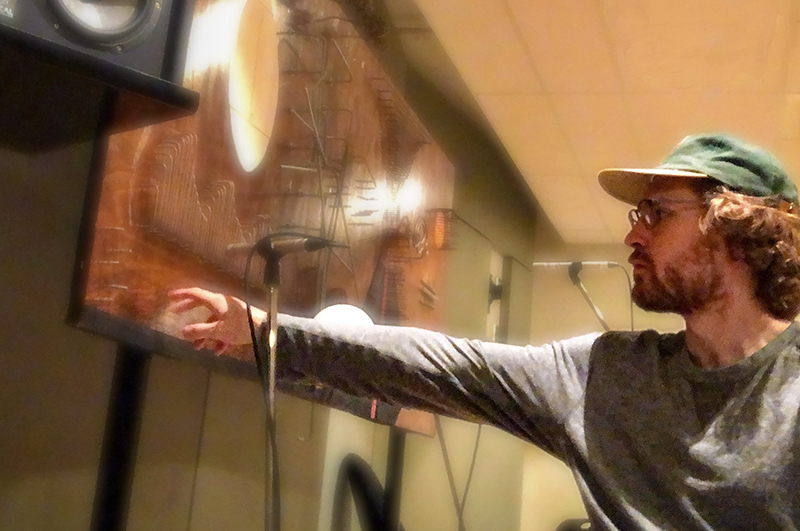
11. Jackson White – 8.244 for Primordium and Modular Synthesizer (05:39)
Jackson White was born into a family of musicians in Toronto. Jack currently lives in Montreal with Anna and his 2 cats. Jack attended Concordia University’s Electroacoustic Studies program and earned a BFA Specialization in Electroacoustic Recording Arts. His musical interests and pursuits are an eclectic mix of hard core electronics, psychedelic rock, songwriting and performing with his brother Max and their band Harmony on Mars.
As an electronic music composer and performer his music has been heard in dance, film, animation and as a member of CLORK (Concordia Laptop Orkestra). As a drummer and bass player he is a regular collaborator in Montréal and Toronto’s indie club scene.
Inspiration for this piece came from the instruments and many hours I’ve spent in Concordia University’s music studio 8.244. The piece opens with phrases played on a custom instrument called the “Primordium”. It is an acoustic performance soundboard consisting of piano strings, bolts, metal rods, small nails, sandpaper with various other pieces and textures attached to a resonant board attached to a wall in the studio. It can be activated with fingers, sticks, brushes, guitar picks etc. As the music progresses, sounds and phrases from the studio’s modular synthesizer join in and begin to interact with the opening acoustic sounds. By the end of the piece the two streams merge creating an active drone which is a synergy of the acoustic and electronic sounds. The electronic sounds were created with the studio’s modular synthesizer which is a mixture of modules from Make Noise and Mutable Instruments that are augmenting the original pure Doepfer system from my first years. Truly a fun and wonderful instrument to play. The evolution of this synth over the past few years has been guided and crafted by both students and instructors of Concordia’s Music Department. The intention of the piece is to merge the two worlds of acoustic and electronic sources and explore the small details that the collisions and layers of sound the Primordium and synth create.
The piece is dedicated to the professors and students I was fortunate to meet and learn from while studying at Concordia.
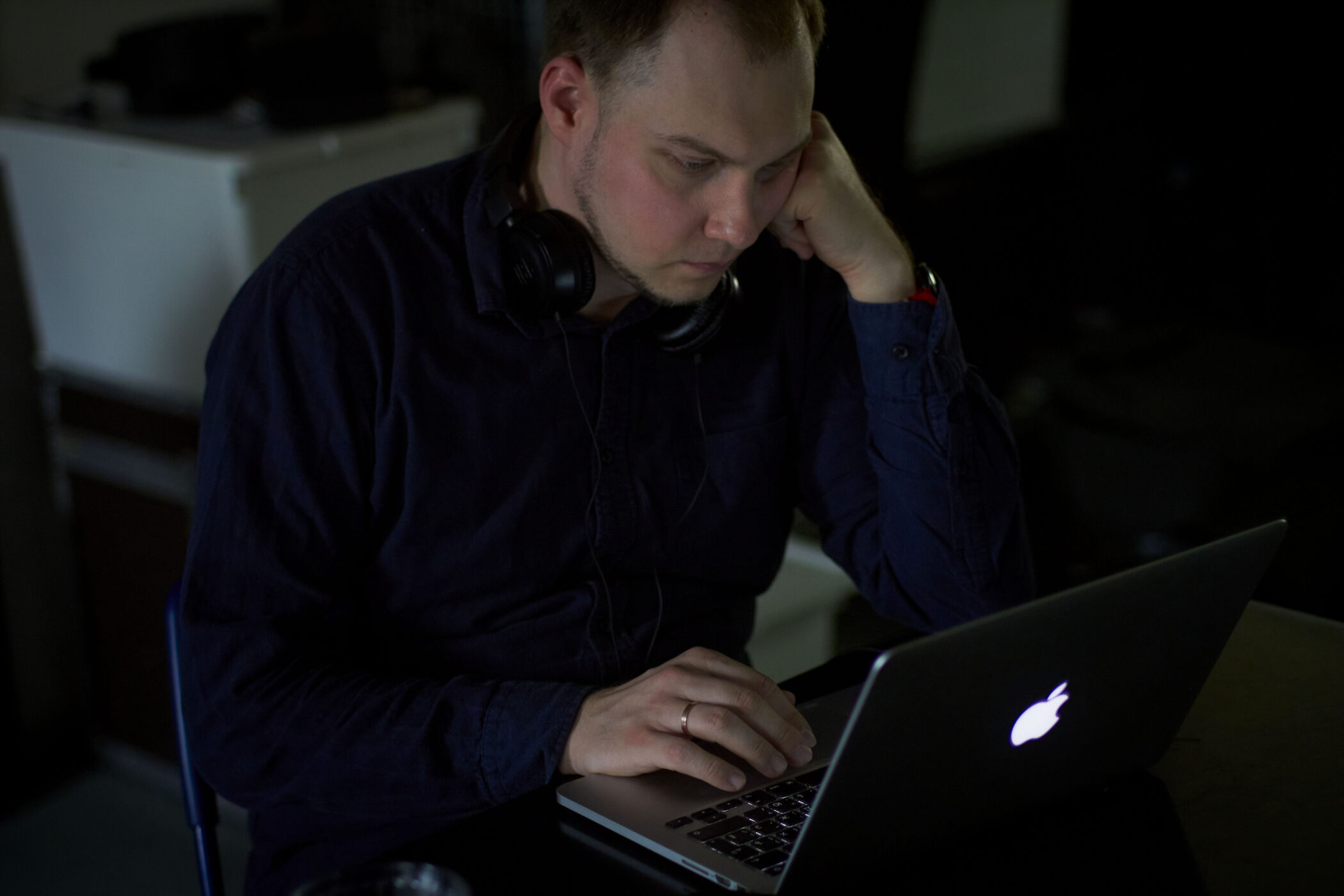
12. Ilia Belorukov – The Road Was Slightly Downhill (6:33)
Eurorack modular synthesizer, Nord Modular G2 Demo, fluteophone, drums, radio, field recordings, software processing.
Ilia Belorukov is a musician from Saint Petersburg, Russia, now based in Novi Sad, Serbia. He works in improvised, noise and electroacoustic music. Ilia practices an experimental approach to sound extraction using saxophone, modular synthesizers and
other instruments. His works have been released on labels such as Clean Feed, SOFA, Moving Furniture, Astral Spirits, Notice Recordings, Raw Tonk, Mikroton and many others. He founded the Intonema label and was one of curators of Spina!Rec label.
So far my main approach is to construct sound pieces without something else behind.
Very rarely I use some narrative from other sources, and only after pieces are created I can give it some ‘poetic’ title.
I used recordings I made on my recent Eurorack modular synthesizer, Nord Modular G2 Demo, fluteophone, selected drums and also included radio and processed field recordings. Almost all the sounds were processed in one way or another. Usually I start to create a new piece by listening to what recordings I have on the computer. It can be different sound sources and not only recent recordings, but something from the past. After that I try to find a good match of two-three sounds of raw material. When I catch the very basic skeleton of sound context, I begin to work on details, add more sounds and layers and create a form of the piece. Usually the final result is quite far from the first version, but the core idea is still present.
One of the most interesting tasks is how to create a space for all the sound sources I’m using. All of them have different characteristics, different acoustics and in the case of electronics usually no acoustics at all, only line signals. Lately for synthesizer I’m working to shape the sound with IR impulses of different guitar or bass amps and combine source line signal with modified sound with impulses. It makes a big difference already, and lately I need to do less post-processing for the synthesizer’s signal, it sounds more ‘acoustic’ and nowadays I like it more.
Next step is to add proper reverberation to it, to make it sound even more acoustic and place it in the space. In this piece acoustic instruments, fluteophone and drums, were processed quite a lot, and the idea was to make it sound more ‘electronic’ than it is in reality. Also I used multilayering technique for fluteophone.
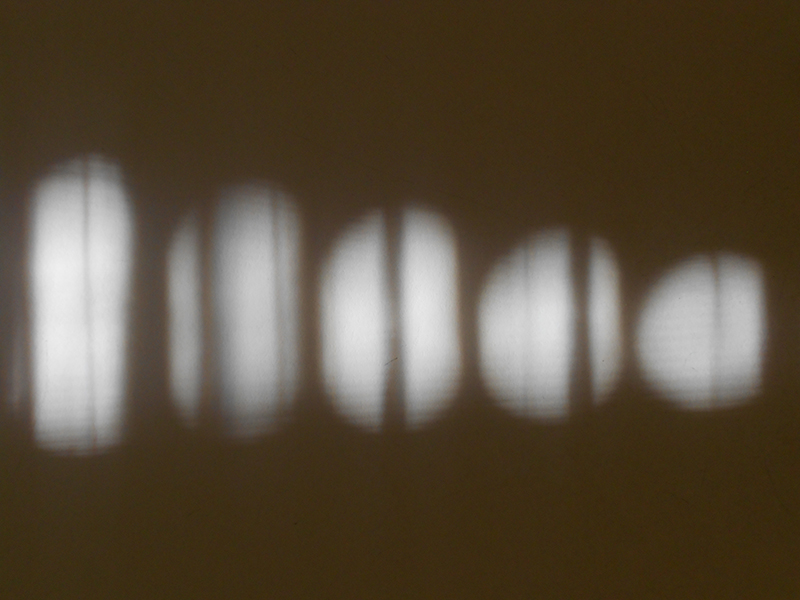
13. Thibault Autheman – Octavia has stolen the horse of her Master to see Jesus (03:21)
Hacking the invisible, subverting scientific models, developing the technology of uselessness are some of the directions that Thibault Autheman is following in his sound and art practice. A research initiated by the fragmented reality of technology and the urban complexity surrounding the giant megalopolis that is now colonizing the space in between the inhabited world. Sound experiments related to emerging phenomena, entropy and chaos theory represent the core of the artist research.
In recent years the practice has shifted towards algorithmic compositions and AI development.
After living for 17 years in London the artist has chosen a more nomadic approach, presenting ARW Accidental Radio Waves, an itinerant project using the specificity of the physical data present on every site to compose and improvise a sound performance.
A closed circuit between the output and input on a small audio mixer is modulating the noise of a small AM/FM receiver tuned in between stations. During the experiment the sound suggesting a horse galloping became apparent. I thought of a men riding first then I saw a woman. The rides sounds both desperate and hopeful, then I understood that she must have been running away and equally wishes to reach for something else. I don’t know if she will succeed, it is the intensity of the rides that matters. The story came after, once I listened to the recording. I believe she must have been a slave to risk death for something still quite uncertain. A means to test her faith. At the same time she has stolen and must see to believe and that’s given her flesh and bones, human with flaws….a strong character. The drone like frequencies rising in the background are made with a small modular set up on the same note but different octaves, Hence Octavia, At the time of Jesus she would have been a Roman slave. Slave wouldn’t have names but they could have numbers maybe in posh family or she had a name before and she was made a slave…Don’t know.
Has she found Jesus ? Don’t know. But with that ride she made her life worth living.
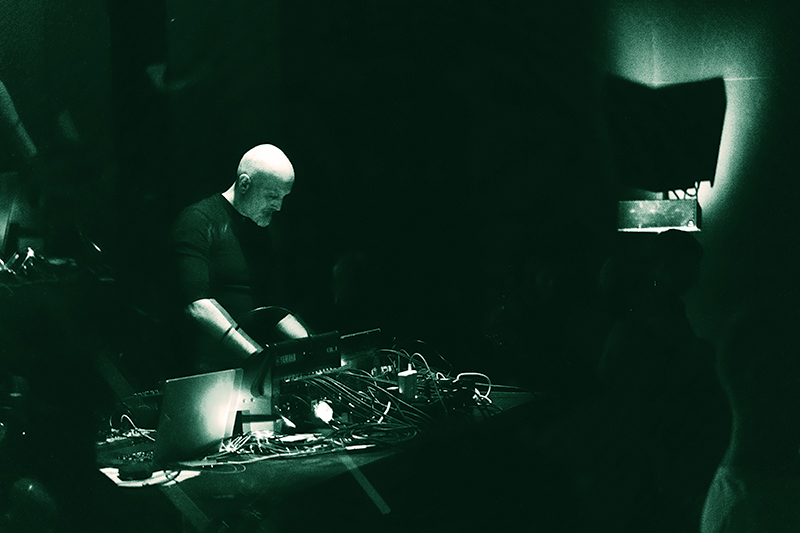
14. Thanos Chrysakis – Inside Forest Summer Rhapsody (09:04)
Thanos Chrysakis is a Greek composer, musician, producer and sound-artist. He is best known for his work in electronic and contemporary music, improvisation, and electro-acoustic music who has released several albums and performed in numerous countries.
He operates the Aural Terrains record label since 2007 + has written music for musicians of the Hyperion Ensemble, the Stockholm Saxophone Quartet, the Hermes Ensemble, the Nemø Ensemble, the Konus Saxophone Quartett, and the Shadanga Duo among others. Close collaborations with Tim Hodgkinson, Vincent Royer, Chris Cundy, Yoni Silver, Lori Freedman, Jason Alder, Julie Kjaer, Henriette Jensen, William Lang, Wilfrido Terrazas, Philippe Brunet, Wade Matthews, Ernesto Rodrigues, Ove Volquartz to name but a few…
I’ve spent a few weeks over the summer living very close to a forest where I did a lot of walking while there. It felt so exuberant to be part of this landscape. Upon returning back to my place I continued working on some music and among other pieces I worked on Inside Forest, Summer Rhapsody.
Incorporating some recordings of alto flute and acoustic guitar as well as some small percussion instruments.
In addition, recordings playing Clavia Nord Modular G2, Moog Voyager rack and some processed field recordings.
I wanted to contrast an electronic part with a somewhat subterranean quality to a more gestural and sparky acoustic part. I knew that I had made several recordings in the past experimenting with the flutes and I wanted to foreground those against a more gritty earthy texture.
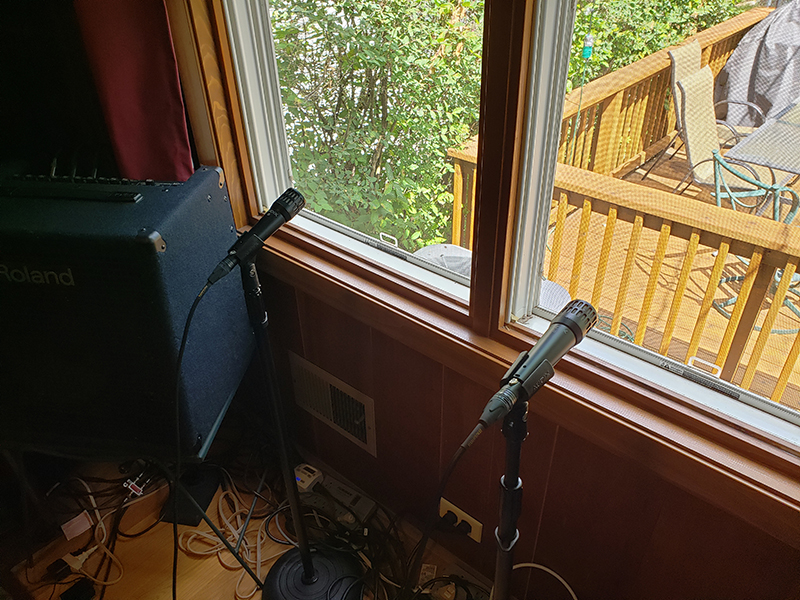
15. Rick Reger – Summer of the Cicada (09:33)
Rick Reger lives in the Chicago area and makes music using vintage-based keyboards and synthesizers: Arp 2600, VCS3, Hohner D6 Clavinet, Fender Rhodes, Mellotron Mk. VI, Mellotron M4000D Mini, Moog Voyager, Hammond organ. From 2012-2015, he was a member of The Margots, with Ken Vandermark and Tim Daisy. He’s been playing keyboards since he was 12 years old. Early in 2025, the label Aural Terrains will be issuing a CD of his original soundscapes titled: “Textures and Tonalities for Analogue Synthesizers and Percussion.”
When I was asked to contribute to Acoustronique, I was delighted because my work typically blends electronic and acoustic sounds. I have a number of percussion instruments I often use, and I was eager to use some for this piece.
But I had a small problem. It was the summertime, and the area where I live was experiencing the emergence of 17-year and 13-year cicadas. That’s a massive number of cicadas, and I knew from experience that recording percussion with mics would be difficult because the cicada “singing” would inevitably bleed into the recordings.
Then one day it occurred to me that I shouldn’t see this as a problem. I should actually record the cicadas and use them as one of the sounds in a piece. I was able to get a fairly clean field recording of them, and I was off to the races in terms of building a piece around that sound.
Aside from my cicada field recording and my VCS3 and Arp 2600 synths (which are a standard part of my process), I used a gong with very small friction mallets, a rainstick and a clavinet played through wah, chorus, flange and delay pedals.
I wanted the piece to evoke the hot, very humid ambience of mid-July in the Chicago area. The rainstick immediately came to mind because it has such a sparse, sandy, desert-like sound. I tried a number of friction mallets on my 32” gong and found that using very small mallets elicited a very compatible sound with what I was getting from the synths. For me, the gong sounds evoked the image of radiant heat rising from a sidewalk.
To marry the electronic with the acoustic my process is often a mixture of knowing instinctively what sounds might work well together with taking time to experiment and try different approaches out.
Often, I just start out with a percussion sound or a synth sound that seems interesting to me. I’ll record it, and then I’ll play different sounds on top of that basic track and see how it sounds. So there’s definitely a hit-or-miss aspect to this.
Other times, I’ll have a very clear idea in mind of a sound that would be compatible in an interesting way, and I’ll just put together a synth patch that aims for that type of sound.
I’ve been buying guitar effects pedals for a number of years, and I plan on acquiring more in the near future. I enjoy the process of chaining them together and running either synths or percussion through them to see what comes out.
On this particular piece, I thought a sound like a distant pedal steel guitar would sound good on the outro. And I was able to adjust my clavinet pedal board so that the clavinet would generate long, sustained tones instead of the usual dry, quick attack and decay. The first several sounds I got from the clavinet weren’t working the way I’d hoped. But I eventually hit on a sound that I think blends in very nicely. Ironically, it sounds very much like a piano played through a Leslie speaker.
So my process is a combination of inspiration, experimentation and, frankly, dumb luck sometimes!
